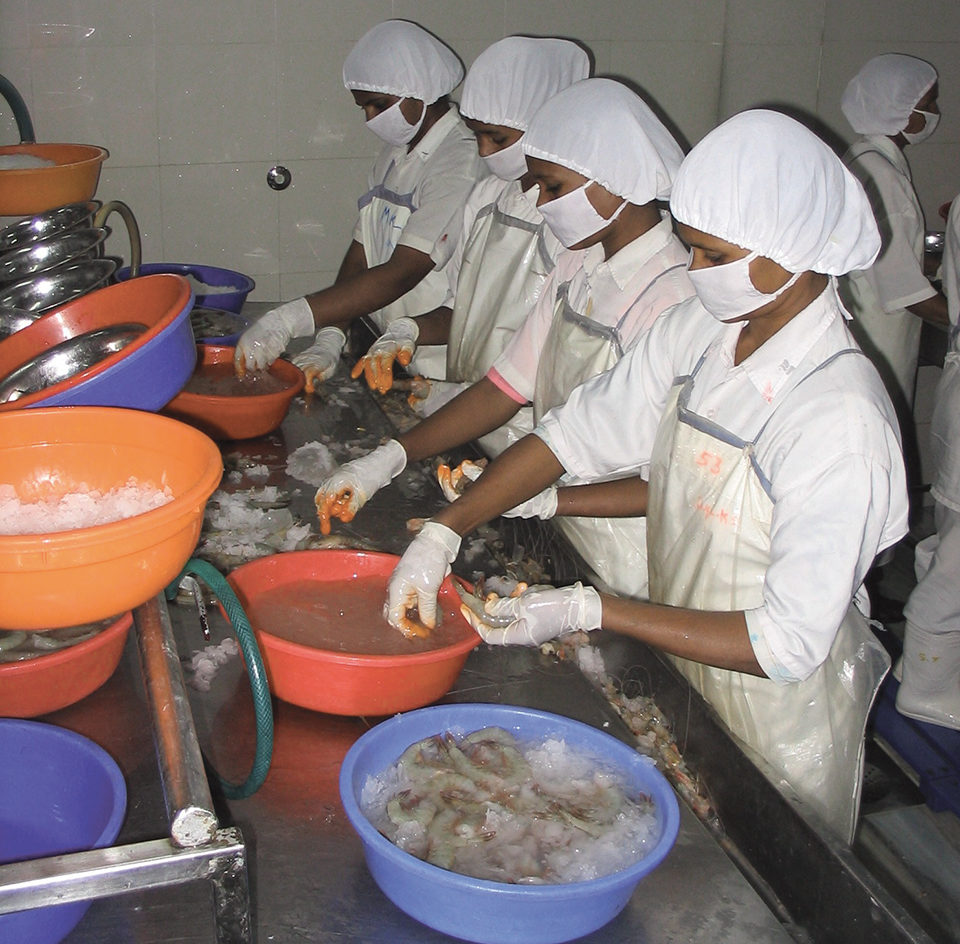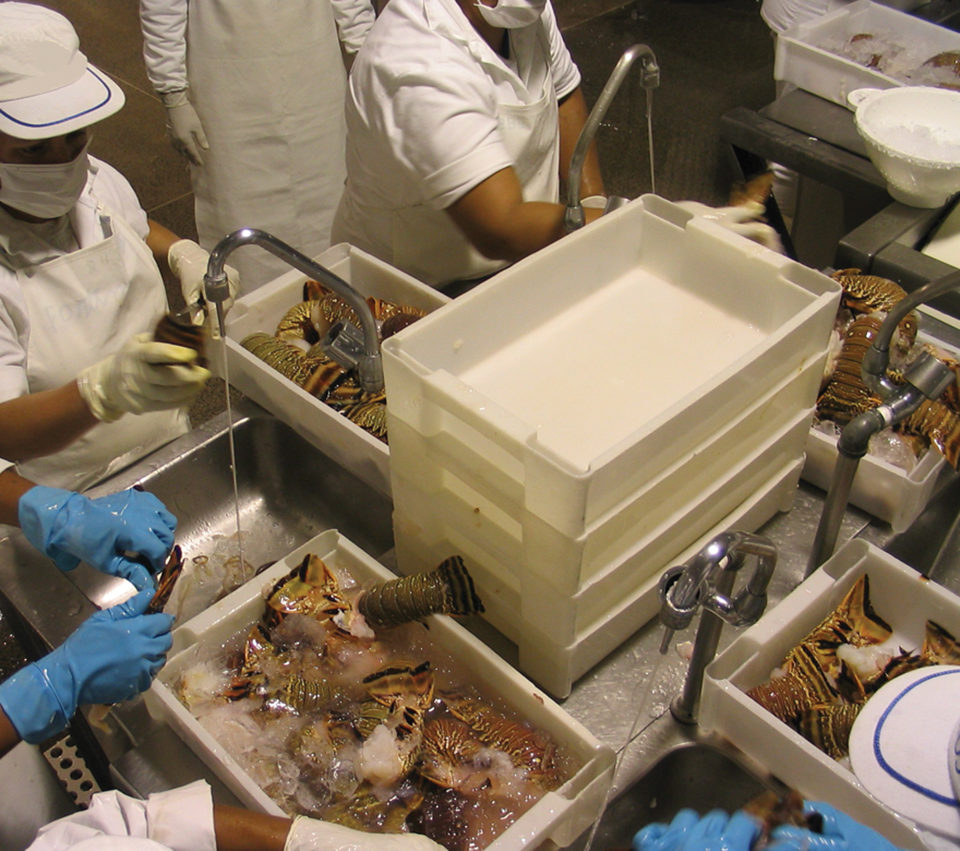Preventive measures minimize exposure to occupational diseases

Increased levels of production and processing of seafood have led to more frequent reporting of occupational health problems among seafood-processing workers, including allergic and other adverse reactions. These occupational health problems result in increased incapacity and absenteeism among affected workers.
Reactions to seafood
Adverse reactions to seafood can generate reactions mediated by the immune system as well as nonimmunological reactions. These reactions can result from exposure to the seafood itself or various nonseafood components in the product.
Nonimmunological reactions in workers can be triggered by contaminants such as parasites, protochordates, bacteria, viruses, marine toxins, and biogenic amines, as well as gases produced by the anaerobic decomposition of fish. Ingredients added during processing and canning can also cause adverse reactions. These ingredients include chemical additives like sodium metabisulfite, spices, and hidden ingredients such as casein.
Allergens
Although seafood contains a wide variety of proteins, only a few are known allergens. The major identified allergens in fish are parvalbumins, which are calcium-binding proteins found mainly in muscle tissue. Strong amino acid homology has been demonstrated for species such as cod, salmon, and mackerel. However, allergic variations have been observed in sensitized individuals.
The major allergens in crustaceans – structural proteins called tropomyosins – have been identified in lobsters, shrimp, and crabs. Interestingly, the allergens among mollusks are not well characterized, even though mollusks are the most commonly processed seafood group. Some studies indicate that tropomyosins, but not parvalbumin, are found in mollusks.
When present in aerosols, these allergenic proteins have been associated with allergic respiratory symptoms. The aerosols generated by snow crab and king crab processing contain not only muscle proteins, but also crab exoskeleton, gills, and internal organs, as well as background material such as sodium chloride crystals, cellulose, synthetic fibers, silicate, pigment constituent particles, and inorganic particles. At least 30 percent of the airborne particles are respirable and can reach the deeper areas of the lungs.

Health effects
Environmental monitoring of seafood-processing plants has identified processing water contaminated with Klebsiella pneumoniae and Pseudomonas, as well as elevated levels of endotoxin thought to be responsible for respiratory symptoms.
The constituents of fish juice associated with skin symptoms comprise traces of biogenic amines, histamine, and cadaverine; degradation compounds associated with postmortem changes; digestive enzymes like pepsin and trypsin; and proteins. Storage conditions can also influence the allergenic nature of seafood extracts by increasing the distribution of various allergenic proteins.
In allergic sensitization, the immune systems of workers develop antibodies against specific allergens identified in the three seafood groupings. These antibodies bind to specific tissue and circulating cells in the sensitized individuals and release various mediators upon contact with the allergen, which in turn causes allergic symptoms.
A number of studies have confirmed that occupational seafood allergies can manifest as asthma, rhinitis, conjunctivitis, urticaria, and protein contact dermatitis. Systemic anaphylactic reactions have also been reported. Another condition associated with occupational exposure to seafood is extrinsic allergic alveolitis.
The proportion of adult asthma attributable to occupational exposure is estimated at 10 percent. The reported prevalence of occupational asthma due to seafood in any processing plant varies 7-36 percent and has been associated with all the major seafood groupings. The differences in prevalence observed can be due to differential exposure to seafood constituents and the allergenic potentials of seafood proteins involved.
Exposure to aerosols from crustaceans seems to be more prevalent than exposure from mollusks and fish. Rhinoconjunctivitis and skin symptoms commonly occur in association and usually precede asthmatic symptoms.
The major skin manifestations associated with seafood are contact urticaria and eczematous contact dermatitis of various types, with prevalences of 3-11 percent. However, biochemical sensitizers such as garlic, spices, and preservatives added to seafood can also cause delayed allergic contact dermatitis.
Varied processing procedures
Seafood-processing plants vary in technology levels and processing procedures, with some smaller workplaces relying entirely on manual handling of seafood and larger companies using highly automated processes. Common processing techniques and sources of potential high-risk exposure to seafood products are outlined in Table 1. Studies of environmental exposure that quantify aerosol particulate and allergen concentrations are summarized in Table 2.
Lopata, Commonly observed causative agents/processes, Table 1
| Causative Agent/Process | Health Effect |
|---|
Causative Agent/Process | Health Effect |
|---|---|
| Seafood proteins (muscle, blood, enzymes) | Rhinoconjunctivitis, asthma, urticaria, dermatitis |
| Seafood toxins | Toxic reactions (local/generalized) |
| Vegetable dust additives (garlic, onion, spices) | Rhinoconjunctivitis, asthma, urticaria, dermatitis |
| Parasites (Anisakis) | Infection, rhinoconjunctivitis, asthma, urticaria |
| Microorganisms (Vibrio, Hepatitis A) | Wound infection, sepsis |
| Bacterial toxins (endotoxin, histamine) | Organic dust toxic syndrome, mucous membrane irritation, rhinoconjunctivitis, asthma, urticaria |
| Mold in humid environments | Infection, rhinoconjunctivitis, asthma, urticaria, hypersensitivity pneumonitis |
Lopata, Common processing techniques, Table 2
| Seafood Category | Processing Technique | Allergen Concentration (µg/m3) | Asthma Prevalence (%) | Source of Potential Exposure |
|---|
Seafood Category | Processing Technique | Allergen Concentration (µg/m3) | Asthma Prevalence (%) | Source of Potential Exposure |
|---|---|---|---|---|
| Crustaceans | ||||
| Crabs, lobsters, crawfish, shrimp | Cooking (boiling or steaming); tailing lobsters; cracking, butchering, and degilling crabs; cutting; grinding; mincing; washing; cooling; heading; peeling; deveining; manual picking of meat; “blowing” shrimp (water jets or compressed air) | 0.003-0.115 | 2-36 | Inhalation of wet aerosols, dermal contact from unprotected handling of shrimp, immersion in water containing extruded gut material |
| Mollusks | ||||
| Oysters, mussels clams, scallops, abalone | Washing, oyster shucking, shellfish depuration, chopping, dicing, slicing | – | 1-23 | Inhalation of wet aerosols, dermal contact from unprotected handling of mollusks |
| Finfish | ||||
| Various species | Heading, degutting, skinning, mincing, filleting, trimming | 0.002-1.000 | 2-8 | Inhalation of wet aerosols, inhalation of dry aerosols from fishmeal bagging and milling, dermal contact from unprotected handling |
Source: “World at Work: Fish-Processing Workers’ – M. F. Jeebhay, T. G. Robins, A. L. Lopata – Occupational and Environmental Medicine, 2004.
The lack of standardized methods for sample collection, extraction, and analysis makes comparisons between various studies difficult. It is notable that generally much higher allergen concentrations were obtained using personal sampling compared to area sampling. There is great variability of exposure within and among various jobs involved in seafood processing, with reported allergen concentrations ranging from 2 ng/m3 in a fish market to 1,000 ng/m3 in a salmon-processing plant.
Aerosolization of seafood components during processing has been identified as a potential high-risk activity for sensitization through the respiratory route. The processes with high potential for aerosol exposure include butchering/grinding, degilling, cracking, and boiling of crabs; tailing of lobsters; “blowing” of prawns; scrubbing of shellfish; degutting, heading, and cooking/boiling of fish; mincing of seafood; and cleaning of the processing line and storage tanks with high-pressure water.
Despite high levels of automation in larger workplaces, inadequate and poorly designed exhaust ventilation systems can pose high risks for workers. Furthermore, processes that generate dry aerosols, such as prawn blowing using compressed air, appear to generate higher particulate levels than wet processes using water jets. Other possible factors – hypertonic saline aerosols, cold air, strenuous physical activity – trigger allergic respiratory symptoms, as well.
Other occupations associated with exposure to seafood include oyster shucker, laboratory technician, researcher, jewelry polisher, restaurant chef, fishmonger, and fisherman.
Worker protection
Preventive measures are key to minimize exposure to occupational diseases. Control measures that reduce the emission of bioaerosols in seafood-processing plants include process separation or enclosure and the use of local extraction ventilation systems for processes and equipment. These changes can reduce aerosol concentrations by over 100 times and prevent new asthma cases. Exposure monitoring for bioaerosols can evaluate the effectiveness of control measures in decreasing the risk of infection and allergic sensitization.
(Editor’s Note: This article was originally published in the September/October 2007 print edition of the Global Aquaculture Advocate.)
Now that you've finished reading the article ...
… we hope you’ll consider supporting our mission to document the evolution of the global aquaculture industry and share our vast network of contributors’ expansive knowledge every week.
By becoming a Global Seafood Alliance member, you’re ensuring that all of the pre-competitive work we do through member benefits, resources and events can continue. Individual membership costs just $50 a year. GSA individual and corporate members receive complimentary access to a series of GOAL virtual events beginning in April. Join now.
Not a GSA member? Join us.
Author
-
Andreas Lopata, Ph.D.
School of Applied Science
RMIT University – Bundoora Campus
Melbourne – Bundoora 3083
Victoria, Australia
Tagged With
Related Posts

Intelligence
Farmed seafood makes sense
Aquaculture has a great story to tell. The industry creates healthful products with economic benefits and does so with increasing environmental stewardship. But that story needs better telling with credible, science-based facts and with transparency and responsibility.

Intelligence
U.S. consumers not achieving seafood guidelines
Research found that 80 to 90 percent of U.S. consumers did not meet federal dietary seafood recommendations and that seafood consumption varies significantly among socio-demographic groups.

Intelligence
Why don’t we eat more seafood?
A variety of factors combine to limit seafood consumption. Seafood is perceived to be expensive, and safety perceptions influence consumer buying decisions. Culture and tradition also play roles in forging seafood-eating habits.

Intelligence
Warning: Shrimp salad may contain shrimp
Crustaceans, fish and any food that contains protein have the potential to cause allergic reactions in some individuals. To protect consumers, seafood businesses must stay abreast of changing regulations.


